Physical Address
304 North Cardinal St.
Dorchester Center, MA 02124
Physical Address
304 North Cardinal St.
Dorchester Center, MA 02124
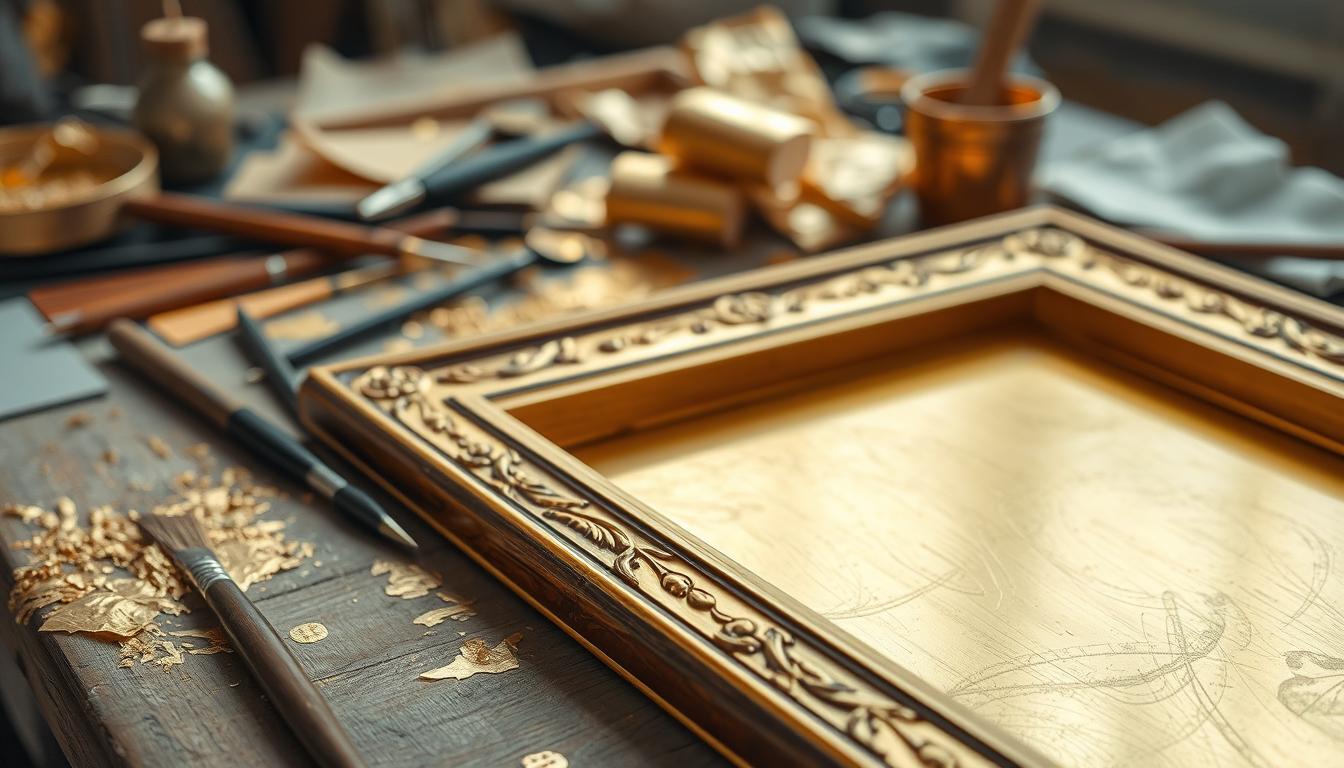
Imagine turning a simple surface into a stunning work of art with gold gilding. The right techniques and process can lead to professional results. The gold gilding process includes preparing the surface, applying adhesive, and placing gold leaf. By following a detailed tutorial, you can master gilding and create beautiful pieces.
To start gilding, you need to know the basics and have the right tools and materials. With practice and patience, you can become skilled in diy gilding. This guide will help both beginners and experienced artists master the art of gold gilding.
Gilding has a long gilding history, starting in ancient times. It’s seen in Egyptian, Greek, and Roman artifacts. Over the years, different gold leaf types have been used, like gold, silver, and copper.
Now, modern gilding applications are found in many areas. This includes art, architecture, interior design, and restoration. To get great results, learning gilding techniques is key. This includes preparing the surface, applying the leaf, and burnishing it.
Gilding has been around for ages, with each culture adding its own twist. It’s used to add luxury and elegance to buildings, from ancient temples to modern ones.
There are many gold leaf types out there. Each has its own special qualities and uses. You can find loose leaf, transfer leaf, and patent leaf, among others.
Modern gilding applications cover a wide range. It’s used in decorative items, furniture, architectural features, and restoration projects. With the right gilding techniques and materials, anyone can get professional-looking results.
To get a great gilding project, you need the right gilding tools and materials. Elizabeth Zanzinger, a pro painter, says you’ll need a solid panel, good sandpaper, Golden Sandable Gesso, Kölner Burnishing Clay, and a gilder’s tip. These gilding materials help you get your surface ready and apply the gold leaf right.
Gold leaf is a big part of gilding, and it comes in different types. A book of gold leaf has 25 leaves, with 20 books in a pack, making 500 leaves. This amount covers about 39.50 sq ft without any extra or overlapping. You’ll also need gilding knives and agate burnishers to work with the gold leaf accurately.
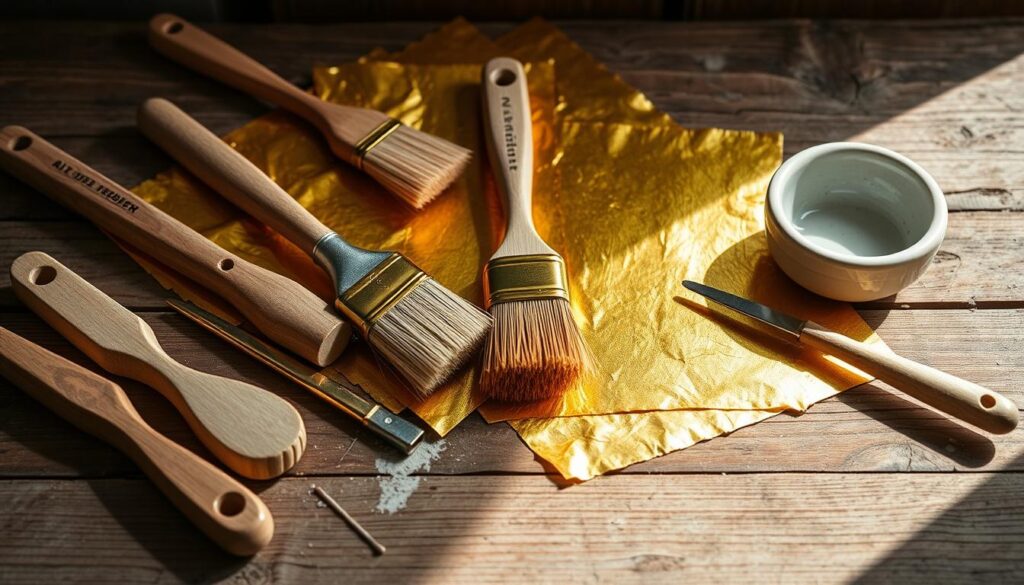
Think about your project and what you want to achieve when picking your gilding materials. For big surfaces, you might need more gold leaf packs. The gold leaf type, like 24kt “Fine Gold” or 23kt, also depends on your project. With the right gilding tools and gold leaf supplies, you’re set to make a beautiful gilded piece.
Other key gilding equipment includes a gilder’s tip for applying gold leaf and a gilding cushion for a soft surface. With these gilding materials and tools, you can get a professional finish and make stunning, detailed designs.
To get great results with gilding, you need to set up your workspace right. Make sure it’s draft-free to keep the gold leaf from moving. This is key for a smooth gilding process.
Organizing your gilding tools is also important. Arrange them so you can easily find what you need. This keeps the gold leaf safe and helps you avoid accidents.
Don’t forget about safety precautions. Wear gloves and a mask to protect yourself from harmful materials. These steps make sure your gilding project is safe and successful.
By following these tips, you can make a safe and effective gilding space. This will help you get professional-looking results.
Getting perfect gilding adhesion starts with surface prep. ArtSparx.com says the surface must be clean, dry, and free of dust. This is key for the gold leaf to stick well and last long.
To get the surface ready, clean it with a gentle detergent and water. This removes dirt, oils, and other stuff that can mess with the gold leaf application. Then, dry the surface with a soft cloth, making sure it’s dry. If needed, apply a primer or sealer for a smooth surface.
Important surface techniques include sanding and using a primer or sealer. Sanding makes the surface smooth. A primer or sealer fills in pores or imperfections. Proper surface prep ensures a strong bond, leading to a beautiful, durable finish.
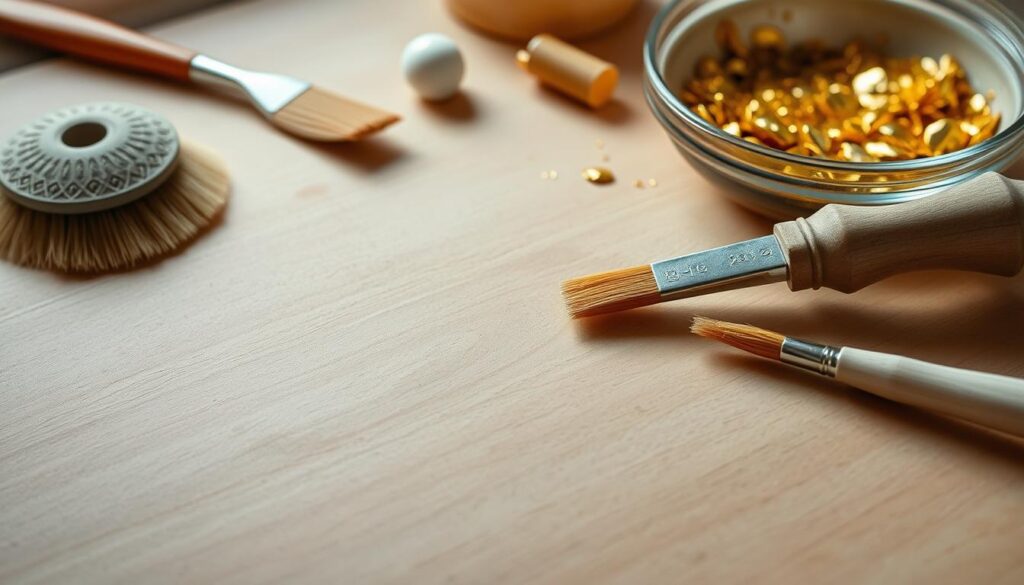
By using these surface preparation tips, you can get perfect adhesion. Always choose high-quality materials and follow the right application steps for the best results.
A beginner’s gold gilding tutorial covers key steps for a pro finish. Elizabeth Zanzinger lists base coating, applying size, laying gold leaf, and burnishing. This guide will teach you to make stunning gilded items.
Start by preparing your surface with a base coat. Use a primer or paint made for gilding. A good base coat ensures the gold leaf sticks well and lasts long.
After preparing your surface, apply size or adhesive for the gold leaf. Choose from water-based or oil-based options. The right choice affects the gold leaf’s durability and look.
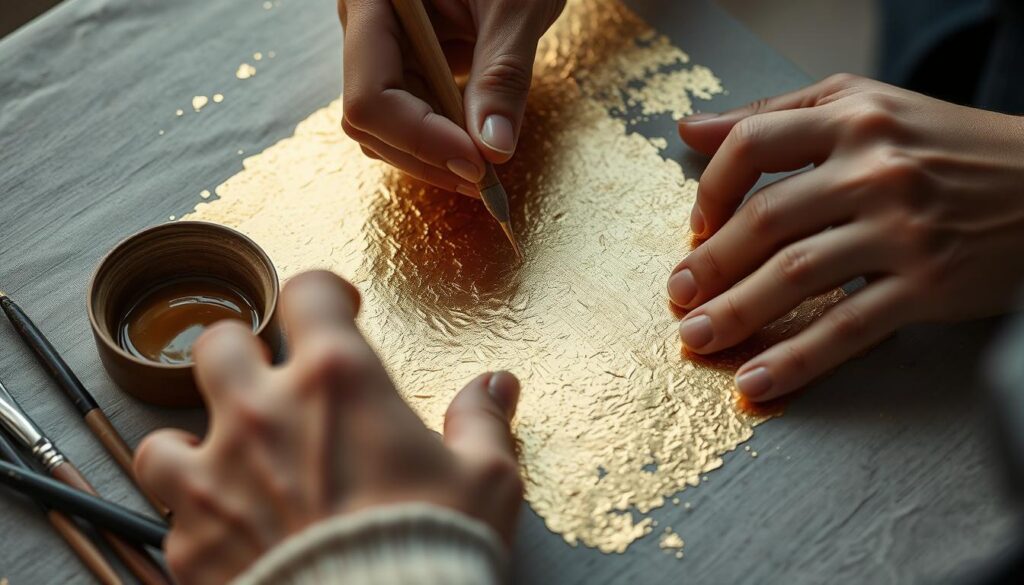
Laying the gold leaf is crucial. It needs patience and care, as the leaf is delicate. Use a brush or cotton swab to apply size and place the leaf gently.
After applying the gold leaf, use burnishing to improve its look. Burnishing smooths the surface with a tool. Be gentle to avoid damaging the leaf. With practice, you’ll master gilding.
When you’re gilding, the surface matters a lot. Wood, metal, and glass each need their own special way to get a great finish. For example, wood needs a certain adhesive and prep to stick the gold leaf well. Metal gilding might use a different size or adhesive to look just right.
Knowing how to gild each surface is key for a pro look. Glass gilding, for instance, needs a lot of care to not damage it. By picking the right materials and methods for each surface, you can get a stunning, lasting gilding effect. Some common methods include:
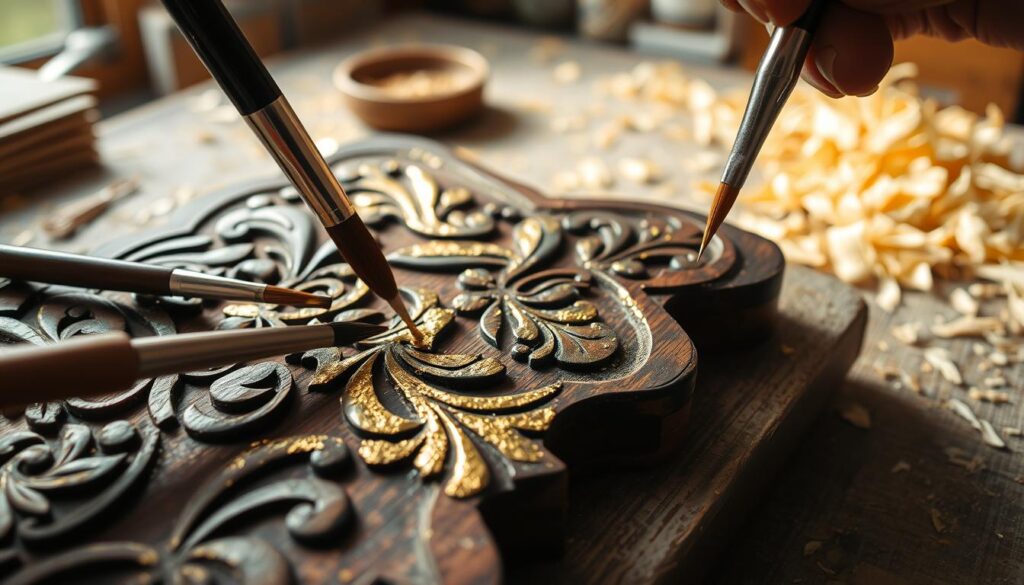
By using these tips and methods, you can get pro results with your gilding projects. Whether it’s wood, metal, glass, or something else, always choose the right materials and techniques. This way, you’ll get a beautiful, lasting finish.
To get professional-looking results in gilding, you need to learn advanced techniques. ArtSparx.com says it takes practice, patience, and dedication. Techniques like layering, texturing, and making intricate designs are key. These skills help you create stunning pieces that show off your gold leaf application skills.
Some important advanced gilding techniques include:
Mastering these techniques lets you make unique and beautiful pieces. They show your skill and expertise in master gilding. Whether it’s a small project or a big commission, these techniques help you get professional results. They impress and inspire everyone.
Keep improving your advanced gilding skills. Always use top-quality materials and tools. Also, follow safety rules for a successful and fun gilding experience. With hard work and dedication, you can become a master gilder. You’ll be able to create stunning pieces that show your expertise in gold leaf application and advanced gilding techniques.
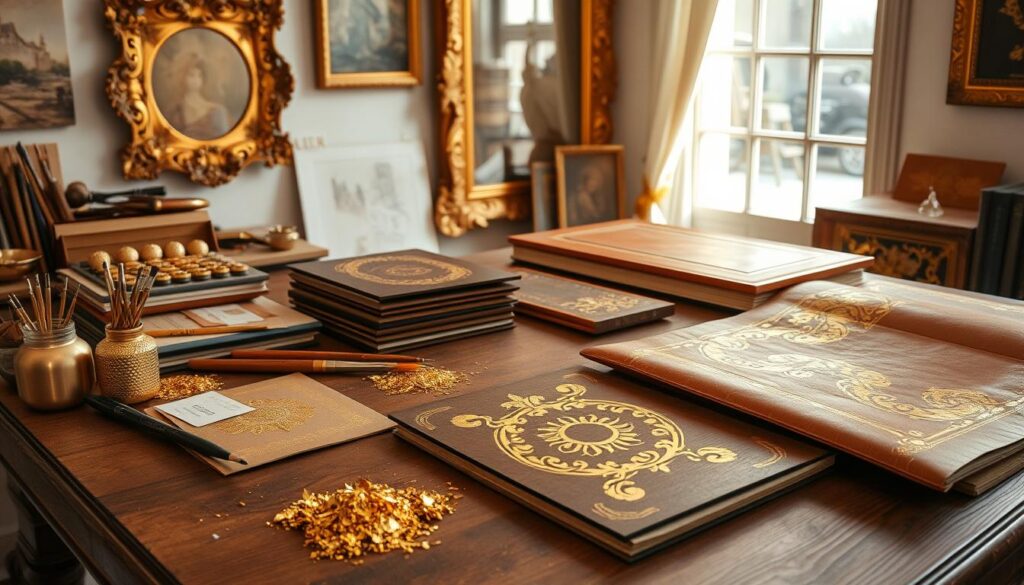
Gilding is an ancient art that needs patience and precision. Even with the best tools and materials, gilding mistakes can happen. Elizabeth Zanzinger says common mistakes include timing issues, handling torn leaf, and fixing adhesion problems.
To avoid these common errors, understanding the causes and solutions is key. Timing issues can be fixed by letting the adhesive rest for about 15 minutes. Handling torn leaf requires gentle care and a gilding brush to smooth it out. Fixing adhesion problems involves applying a small amount of adhesive and gently pressing the leaf onto the surface.
Other gilding problems include uneven application, air bubbles, and peeling. To solve these, find the root cause and act on it. Uneven application might come from poor surface prep. Air bubbles can be avoided by applying the leaf slowly and smoothly. Peeling can be prevented by ensuring the adhesive is dry before handling the gilded surface.
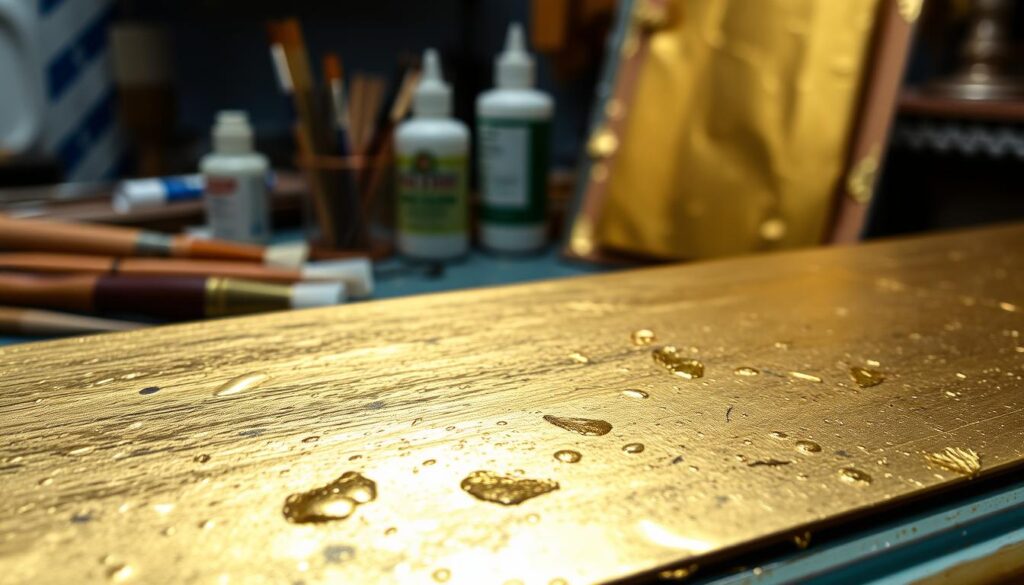
Knowing these troubleshooting issues and how to prevent them can lead to professional-looking results. Always follow the manufacturer’s instructions for your materials. If you face any problems, don’t hesitate to ask experienced gilders for help.
Gilding effects and finishes can make a project stand out. The Gold Leaf Knowledge Center says techniques like distressed gold leaf and pattern applications can make a project special. Using different metals together can also add a unique touch.
Distressed gold leaf looks can be made to look worn and vintage. This is done by scratching and wearing away the gold leaf. It creates a unique and interesting look. 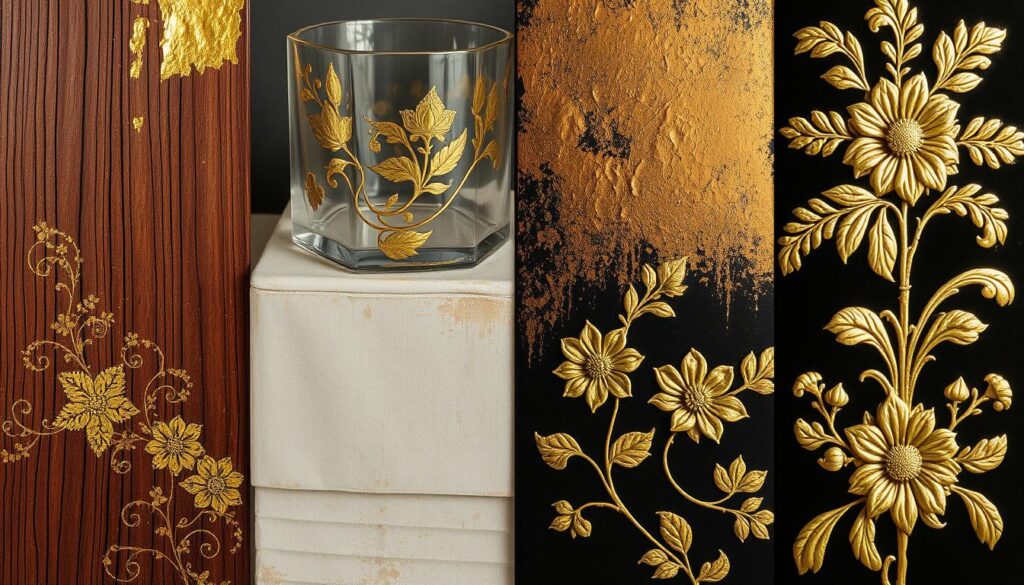
Applying gold leaf in patterns or designs is another way to enhance a project. This can be done with stencils or free-handing. Gilding effects and finishes can help create many patterns, from simple to complex.
Using different metals together can also create interesting effects. For example, mixing gold and silver leaf can make a beautiful two-toned look. By trying out different metals and techniques, gilders can achieve many unique effects and finishes.
To keep your gilded pieces looking great, gilding protection and gilding maintenance are key. ArtSparx.com says it’s vital to protect and maintain these pieces. This means cleaning them often, storing them right, and handling them with care to avoid damage.
Here are some important steps for preserving gilded pieces:
By following these steps and caring for your gilded pieces, they’ll stay beautiful for years. Gilding maintenance is a continuous task, but it’s worth it to keep your precious items safe.
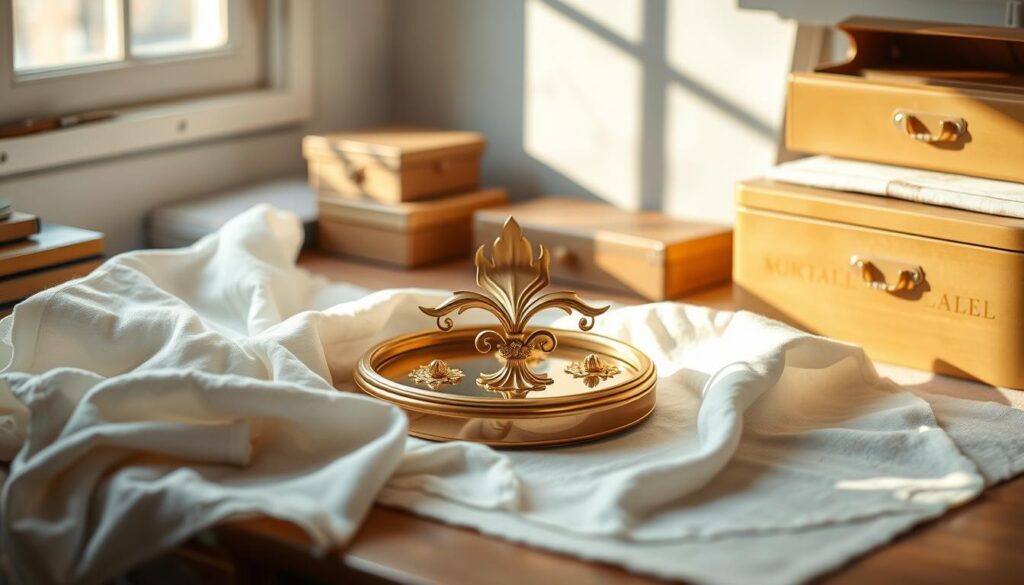
Remember, gentle and patient care is the secret to gilding protection and preserving gilded pieces. With the right care, your gilded treasures can be enjoyed by future generations.
Proper care and maintenance are essential for preserving the beauty and longevity of gilded pieces, and with the right techniques and materials, you can help ensure your pieces remain stunning for years to come.
Now that you know how to gild, it’s time to get creative. You can try gilding on home decor, art, and frames. Add elegance to your home with gilded picture frames, mirrors, or vases.
Some popular creative gilding ideas include:
Always follow the basic steps of gilding. This includes surface prep, applying size or adhesive, laying gold leaf, and burnishing. With practice and patience, you can make stunning gilding projects. So, get creative and start exploring gilding ideas and home decor gilding!
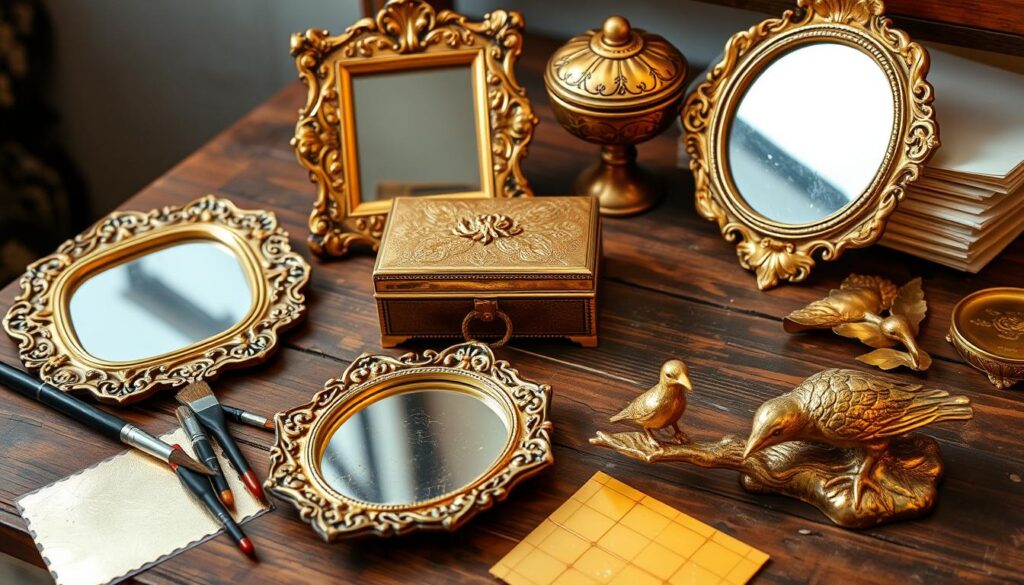
To get museum-quality gilding, focus on detail, patience, and practice. Elizabeth Zanzinger says these are key to mastering professional gilding. By using gilding tips and professional techniques, you can make pieces as beautiful as those in museums.
When aiming for museum-quality results, choose top-notch materials and prepare your surface well. About 60% of gilding problems come from bad material choice. Using better materials can make your gilded finish last 30% longer.
Here are some professional gilding tips to remember:
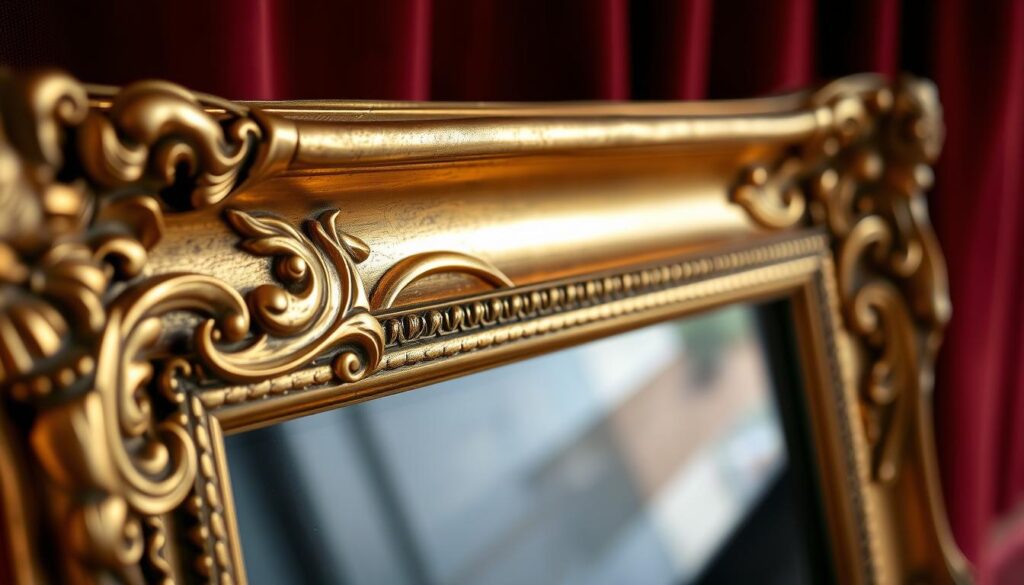
By following these gilding tips and professional techniques, you can make stunning, museum-quality pieces. Always use the best materials, prepare your surface well, and apply gold leaf carefully for the best results.
Unlock your craft’s true potential with the golden touch of gilding. You’ve learned the intricate techniques and sharpened your skills. Now, you can transform your work in countless ways.
Whether it’s for home decor, furniture, or art, gold leaf can revitalize your creations. It adds a luxurious finish that makes your work stand out.
Gilding’s versatility lets you try different looks, from shiny to distressed. Mix gold with silver or copper for striking contrasts. Your projects will shine with elegance, captivating everyone who sees them.
With this guide, you’re ready to unleash your creativity. Let the golden touch elevate your craft. It’s your key to artistic expression and elevated craftsmanship.